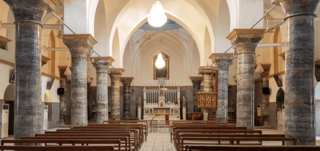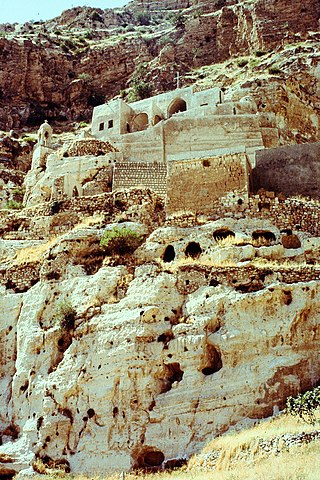Related Research Articles

The Assyrian Church of the East (ACOE), sometimes called the Church of the East and officially known as the Holy Apostolic Catholic Assyrian Church of the East (HACACE), is an Eastern Christian church that follows the traditional Christology and ecclesiology of the historical Church of the East. It belongs to the eastern branch of Syriac Christianity, and employs the Divine Liturgy of Saints Addai and Mari belonging to the East Syriac Rite. Its main liturgical language is Classical Syriac, a dialect of Eastern Aramaic, and the majority of its adherents are ethnic Assyrians.

The Chaldean Catholic Church is an Eastern Catholic particular church in full communion with the Holy See and the rest of the Catholic Church, and is headed by the Chaldean Patriarchate. Employing in its liturgy the East Syriac Rite in the Syriac dialect of the Aramaic language, it is part of Syriac Christianity. Headquartered in the Cathedral of Our Lady of Sorrows, Baghdad, Iraq, since 1950, it is headed by the Catholicos-Patriarch Louis Raphaël I Sako. In 2010, it had a membership of 490,371, of whom 310,235 (63.27%) lived in the Middle East.

Shimun VIII Yohannan Sulaqa was the first Patriarch of what was to become the Shemʿon line of Chaldean Catholic Church, from 1553 to 1555, after it absorbed this Church of the East patriarchate into full communion with the Holy See and the Catholic Church.

Dioceses of the Church of the East after 1552 were dioceses of the Church of the East and its subsequent branches, both traditionalist and pro-Catholic.

Chaldean Catholic Eparchy of Amadiya was a historical eparchy (diocese) of the Chaldean Catholic Church, until it was united with the Chaldean Catholic Eparchy of Zakho in 2013.

The Church of the East or the East Syriac Church, also called the Church of Seleucia-Ctesiphon, the Persian Church, the Assyrian Church, the Babylonian Church or the Nestorian Church, is one of three major branches of Nicene Eastern Christianity that arose from the Christological controversies of the 5th and 6th centuries, alongside the Miaphisite churches and the Chalcedonian Church.

The patriarch of the Church of the East is the patriarch, or leader and head bishop of the Church of the East. The position dates to the early centuries of Christianity within the Sassanid Empire, and the Church has been known by a variety of names, including the Church of the East, Nestorian Church, the Persian Church, the Sassanid Church, or East Syrian.

Mar Shemʿon VII Ishoʿyahb, born Īshōʿyahb bar Māmā, was Patriarch of the Church of the East from 1539 to 1558, with residence in Rabban Hormizd Monastery.
Shimun X was Patriarch of the Shemʿon line of primates of the Church of the East, from c. 1600 to c. 1638. He is claimed both by the Chaldean Catholic Church and the Assyrian Church of the East. Upon accession to the patriarchal throne, he moved his seat from Urmia to Salmas, and also resided in Khananis near Qodshanis. He succeeded Patriarch Shimun IX Dinkha who was in full communion with the Catholic Church. Unlike his predecessor, who was officially recognized by Rome as the Patriarch of the Chaldeans, Shimun X was not formally recognized by the Catholic Church because his election was based on hereditary principle, reintroduced after the death of his predecessor. Hereditary succession was considered an unacceptable practice by the Rome. In 1616, contacts between patriarch Shimun X and the Catholic Church were initiated, upon arrival of Catholic missionaries to the region. Patriarch composed a profession of faith, that was sent to Rome for assessment. Upon examination, Shimun′s profession was found inadequate, and he was not received into communion with the Catholic Church. Similar attempt was made in 1619, but wit no final conclusion. Because of such complex situation, his legacy was viewed differently along denominational lines, and claimed by both sides. He is considered as pro-Catholic by the Chaldean Catholic Church, and also as non-Catholic by the Assyrian Church of the East.
Mar Shimun XIV Shlemon was the Catholicos-Patriarch of the Church of the East of the Shem'on line from 1700 until 1740.
Mar Shimun XV Maqdassi Mikhail was the Catholicos-Patriarch of the Church of the East of the Shem'on line from 1740 until 1780.
Mar Shimun XVI Yohannan was Patriarch of the Shem'on line (Qodshanis) of the Church of the East, from 1780. In 1804, he became the sole Patriarch among traditionalist Christians of the East Syriac Rite, because the rival Patriarch Eliya XII (1778-1804) of the Eliya line died without successor. Shimun XVI remained patriarch until his death in 1820.

Eliya VI was Patriarch of the Church of the East from 1558 to 1591, with residence in Rabban Hormizd Monastery, near Alqosh, in modern Iraq. In older historiography, he was designated as Eliya VI, but later renumbered as Eliya "VII" by some authors, who believed that during the period from 1558 to 1591 there were two successive Eliya patriarchs. After the resolution of several chronological questions, he was designated again as Eliya VI, and that numeration is accepted in recent scholarly works.
Mar Elīyā V was the patriarch of the Church of the East from September 1502 until his death in 1504.

Eliya XI was Patriarch of the Church of the East from 1722 to 1778, with his residence in Rabban Hormizd Monastery, near Alqosh, in modern Iraq. His father, the priest Hoshaba, was the brother of the previous patriarch Eliya X. Upon that patriarch's death, Eliya XI was elected to the patriarchal see, and enthroned on 25 December 1722.

Eliya XII was Patriarch of the Church of the East, from 1778 to 1804, with formal residence in Rabban Hormizd Monastery, near Alqosh, in modern Iraq. His birth name was Ishoyahb, and he was the elder son of priest Abraham, who was brother of the previous patriarch Eliya XI (1722-1778). In 1744, Ishoyahb was consecrated as metropolitan, and designated as presumptive successor by his paternal uncle, patriarch Eliya XI, who died in 1778, and Ishoyahb succeeded him, as patriarch Eliya XII. His tenure was marked by a prolonged rivalry with his pro-Catholic cousin Yohannan Hormizd, who also claimed the patriarchal throne. In 1804, Eliya XII died and was buried in the Rabban Hormizd Monastery, as the last patriarch of the senior Eliya line.
Mar Shemʿon VI was Patriarch of the Church of the East from 1504 until his death on 5 August 1538. Shemon is credited with revising the East Syriac Rite, replacing commemorations of traditional saints and martyrs with new ones, especially for those who had founded monasteries. Following his death, he was succeeded as Patriarch by his brother Shemon VII Ishoyahb, who had been natar kursya throughout his reign; since the reign of Shemon IV the role of Patriarch had been passed hereditarily. Shemon VI was buried alongside other Patriarchs of his era at Rabban Hormizd Monastery near Mosul, his residence while he had been Patriarch; his epitaph, recorded by Vosté, was inscribed by a priest named Israel.
References
- ↑ Wilmshurst 2000, p. 23, 50, 73, 87, 94, 102, 279, 350, 356, 414, 416, 417.
- ↑ Wilmshurst 2019, p. 804.
- ↑ Baum & Winkler 2003, p. 118, 174.
- ↑ Chaldean Patriarchate of Babylon
- ↑ Tfinkdji 1914, p. 457.
- ↑ Wilmshurst 2000, p. 102.
- ↑ Lampart 1966, p. 58.
- ↑ Tisserant 1931, p. 230.
- ↑ Murre van den Berg 1999, p. 252-253.
- ↑ Burleson & Rompay 2011, p. 481-491.